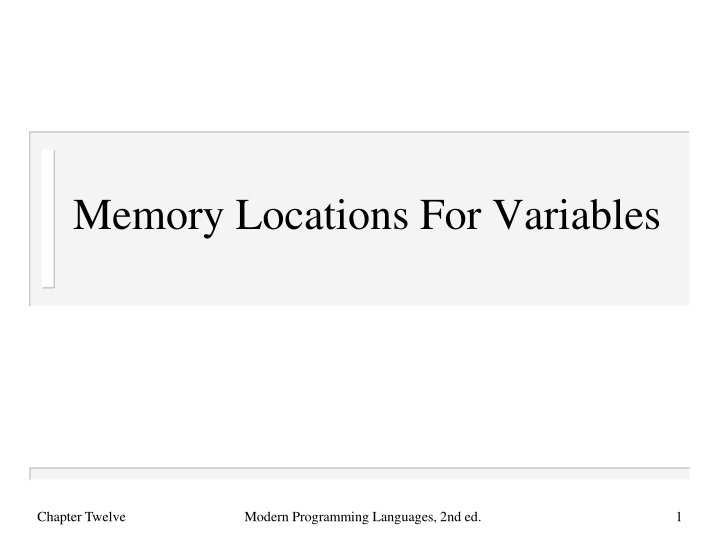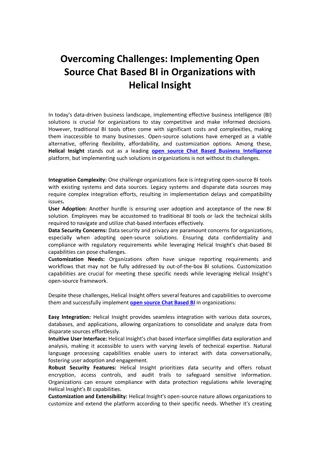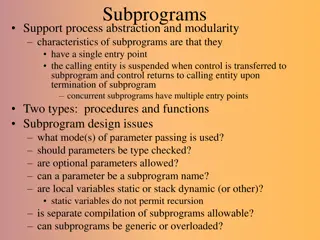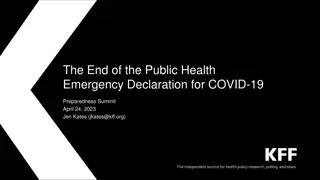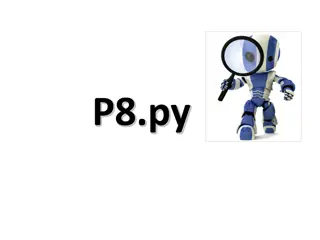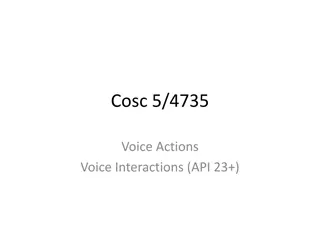Actions in Implementing Subprograms
When calling a subprogram, the environment is saved, local variables are stored, parameter passing is handled, and control is transferred. Upon termination, parameters are returned, variables deallocated, and control is restored. Subprogram linkage involves managing these actions using activation records, as seen in languages like FORTRAN. Activation records store local variables, parameters, return addresses, and functional values for functions, enabling efficient memory access and control transfer.
Download Presentation

Please find below an Image/Link to download the presentation.
The content on the website is provided AS IS for your information and personal use only. It may not be sold, licensed, or shared on other websites without obtaining consent from the author.If you encounter any issues during the download, it is possible that the publisher has removed the file from their server.
You are allowed to download the files provided on this website for personal or commercial use, subject to the condition that they are used lawfully. All files are the property of their respective owners.
The content on the website is provided AS IS for your information and personal use only. It may not be sold, licensed, or shared on other websites without obtaining consent from the author.
E N D
Presentation Transcript
Memory Locations For Variables Chapter Twelve Modern Programming Languages, 2nd ed. 1
A Binding Question Variables are bound (dynamically) to values Those values must be stored somewhere Therefore, variables must somehow be bound to memory locations How? Chapter Twelve Modern Programming Languages, 2nd ed. 2
Functional Meets Imperative Imperative languages expose the concept of memory locations: a := 0 Store a zero in a s memory location Functional languages hide it: val a = 0 Bind a to the value zero But both need to connect variables to values represented in memory So both face the same binding question Chapter Twelve Modern Programming Languages, 2nd ed. 3
Outline Activation records Static allocation of activation records Stacks of activation records Handling nested function definitions Functions as parameters Long-lived activation records Chapter Twelve Modern Programming Languages, 2nd ed. 4
Function Activations The lifetime of one execution of a function, from call to corresponding return, is called an activation of the function When each activation has its own binding of a variable to a memory locations, it is an activation-specific variable (Also called dynamic or automatic) Chapter Twelve Modern Programming Languages, 2nd ed. 5
Activation-Specific Variables In most modern languages, activation- specific variables are the most common kind: fun days2ms days = let val hours = days * 24.0 val minutes = hours * 60.0 val seconds = minutes * 60.0 in seconds * 1000.0 end; Chapter Twelve Modern Programming Languages, 2nd ed. 6
Block Activations For block constructs that contain code, we can speak of an activation of the block The lifetime of one execution of the block A variable might be specific to an activation of a particular block within a function: fun fact n = if (n=0) then 1 else let val b = fact (n-1) in n*b end; Chapter Twelve Modern Programming Languages, 2nd ed. 7
Other Lifetimes For Variables Most imperative languages have a way to declare a variable that is bound to a single memory location for the entire runtime Obvious binding solution: static allocation (classically, the loader allocates these) int count = 0; int nextcount() { count = count + 1; return count; } Chapter Twelve Modern Programming Languages, 2nd ed. 8
Scope And Lifetime Differ In most modern languages, variables with local scope have activation-specific lifetimes, at least by default However, these two aspects can be separated, as in C: int nextcount() { static int count = 0; count = count + 1; return count; } Chapter Twelve Modern Programming Languages, 2nd ed. 9
Other Lifetimes For Variables Object-oriented languages use variables whose lifetimes are associated with object lifetimes Some languages have variables whose values are persistent: they last across multiple executions of the program Today, we will focus on activation-specific variables Chapter Twelve Modern Programming Languages, 2nd ed. 10
Activation Records Language implementations usually allocate all the activation-specific variables of a function together as an activation record The activation record also contains other activation-specific data, such as Return address: where to go in the program when this activation returns Link to caller s activation record: more about this in a moment Chapter Twelve Modern Programming Languages, 2nd ed. 11
Block Activation Records When a block is entered, space must be found for the local variables of that block Various possibilities: Preallocate in the containing function s activation record Extend the function s activation record when the block is entered (and revert when exited) Allocate separate block activation records Our illustrations will show the first option Chapter Twelve Modern Programming Languages, 2nd ed. 12
Outline Activation-specific variables Static allocation of activation records Stacks of activation records Handling nested function definitions Functions as parameters Long-lived activation records Chapter Twelve Modern Programming Languages, 2nd ed. 13
Static Allocation The simplest approach: allocate one activation record for every function, statically Older dialects of Fortran and Cobol used this system Simple and fast Chapter Twelve Modern Programming Languages, 2nd ed. 14
Example Naddress ARRaddress FUNCTION AVG (ARR, N) DIMENSION ARR(N) SUM = 0.0 DO 100 I = 1, N SUM = SUM + ARR(I) 100 CONTINUE AVG = SUM / FLOAT(N) RETURN END return address I SUM AVG Chapter Twelve Modern Programming Languages, 2nd ed. 15
Drawback Each function has one activation record There can be only one activation alive at a time Modern languages (including modern dialects of Cobol and Fortran) do not obey this restriction: Recursion Multithreading Chapter Twelve Modern Programming Languages, 2nd ed. 16
Outline Activation-specific variables Static allocation of activation records Stacks of activation records Handling nested function definitions Functions as parameters Long-lived activation records Chapter Twelve Modern Programming Languages, 2nd ed. 17
Stacks Of Activation Records To support recursion, we need to allocate a new activation record for each activation Dynamic allocation: activation record allocated when function is called For many languages, like C, it can be deallocated when the function returns A stack of activation records: stack frames pushed on call, popped on return Chapter Twelve Modern Programming Languages, 2nd ed. 18
Current Activation Record Before, static: location of activation record was determined before runtime Now, dynamic: location of the current activation record is not known until runtime A function must know how to find the address of its current activation record Often, a machine register is reserved to hold this Chapter Twelve Modern Programming Languages, 2nd ed. 19
int fact(int n) { int result; if (n<2) result = 1; else result = n * fact(n-1); return result; } C Example We are evaluating fact(3). This shows the contents of memory just before the recursive call that creates a second activation. current activation record n: 3 return address previous activation record result: ? Chapter Twelve Modern Programming Languages, 2nd ed. 20
This shows the contents of memory just before the third activation. int fact(int n) { int result; if (n<2) result = 1; else result = n * fact(n-1); return result; } current activation record n: 2 n: 3 return address return address previous activation record result: ? previous activation record result: ? Chapter Twelve Modern Programming Languages, 2nd ed. 21
This shows the contents of memory just before the third activation returns. int fact(int n) { int result; if (n<2) result = 1; else result = n * fact(n-1); return result; } current activation record n: 1 n: 2 n: 3 return address return address return address previous activation record previous activation record result: ? previous activation record result: ? result: 1 Chapter Twelve Modern Programming Languages, 2nd ed. 22
The second activation is about to return. int fact(int n) { int result; if (n<2) result = 1; else result = n * fact(n-1); return result; } current activation record n: 1 n: 2 n: 3 return address return address return address previous activation record previous activation record previous activation record result: ? result: 1 result: 2 Chapter Twelve Modern Programming Languages, 2nd ed. 23
The first activation is about to return with the result fact(3) = 6. int fact(int n) { int result; if (n<2) result = 1; else result = n * fact(n-1); return result; } current activation record n: 1 n: 2 n: 3 return address return address return address previous activation record previous activation record previous activation record result: 1 result: 2 result: 6 Chapter Twelve Modern Programming Languages, 2nd ed. 24
ML Example current activation record We are evaluating halve [1,2,3,4]. This shows the contents of memory just before the recursive call that creates a second activation. parameter: [1,2,3,4] return address previous activation record a: 1 b: 2 fun halve nil = (nil, nil) | halve [a] = ([a], nil) | halve (a::b::cs) = let val (x, y) = halve cs in (a::x, b::y) end; cs: [3,4] x: ? y: ? value to return: ? Chapter Twelve Modern Programming Languages, 2nd ed. 25
current activation record parameter: [3,4] parameter: [1,2,3,4] This shows the contents of memory just before the third activation. return address return address previous activation record previous activation record a: 3 a: 1 b: 4 b: 2 fun halve nil = (nil, nil) | halve [a] = ([a], nil) | halve (a::b::cs) = let val (x, y) = halve cs in (a::x, b::y) end; cs: [] cs: [3,4] x: ? x: ? y: ? y: ? value to return: ? value to return: ? Chapter Twelve Modern Programming Languages, 2nd ed. 26
This shows the contents of memory just before the third activation returns. current activation record parameter: [3,4] parameter: [1,2,3,4] parameter: [] return address return address return address previous activation record value to return: ([], []) previous activation record previous activation record a: 3 a: 1 b: 4 b: 2 fun halve nil = (nil, nil) | halve [a] = ([a], nil) | halve (a::b::cs) = let val (x, y) = halve cs in (a::x, b::y) end; cs: [] cs: [3,4] x: ? x: ? y: ? y: ? value to return: ? value to return: ? Chapter Twelve Modern Programming Languages, 2nd ed. 27
The second activation is about to return. current activation record parameter: [3,4] parameter: [1,2,3,4] parameter: [] return address return address return address previous activation record value to return: ([], []) previous activation record previous activation record a: 3 a: 1 b: 4 b: 2 fun halve nil = (nil, nil) | halve [a] = ([a], nil) | halve (a::b::cs) = let val (x, y) = halve cs in (a::x, b::y) end; cs: [] cs: [3,4] x: ? x: [] y: ? y: [] value to return: ([3], [4]) value to return: ? Chapter Twelve Modern Programming Languages, 2nd ed. 28
The first activation is about to return with the result halve [1,2,3,4] = ([1,3],[2,4]) current activation record parameter: [3,4] parameter: [1,2,3,4] parameter: [] return address return address return address previous activation record value to return: ([], []) previous activation record previous activation record a: 3 a: 1 b: 4 b: 2 fun halve nil = (nil, nil) | halve [a] = ([a], nil) | halve (a::b::cs) = let val (x, y) = halve cs in (a::x, b::y) end; cs: [] cs: [3,4] x: [] x: [3] y: [] y: [4] value to return: ([1,3],[2,4]) value to return: ([3], [4]) Chapter Twelve Modern Programming Languages, 2nd ed. 29
Outline Activation-specific variables Static allocation of activation records Stacks of activation records Handling nested function definitions Functions as parameters Long-lived activation records Chapter Twelve Modern Programming Languages, 2nd ed. 30
Nesting Functions What we just saw is adequate for many languages, including C But not for languages that allow this trick: Function definitions can be nested inside other function definitions Inner functions can refer to local variables of the outer functions (under the usual block scoping rule) Like ML, Ada, Pascal, etc. Chapter Twelve Modern Programming Languages, 2nd ed. 31
Example fun quicksort nil = nil | quicksort (pivot::rest) = let fun split(nil) = (nil,nil) | split(x::xs) = let val (below, above) = split(xs) in if x<pivot then (x::below, above) else (below, x::above) end; val (below, above) = split(rest) in quicksort below @ [pivot] @ quicksort above end; Chapter Twelve Modern Programming Languages, 2nd ed. 32
The Problem How can an activation of the inner function (split) find the activation record of the outer function (quicksort)? It isn t necessarily the previous activation record, since the caller of the inner function may be another inner function Or it may call itself recursively, as split does Chapter Twelve Modern Programming Languages, 2nd ed. 33
current activation record first caller: a quicksort activation a split activation another split activation parameter parameter parameter return address return address return address previous activation record previous activation record previous activation record quicksort s variables: pivot, rest, etc. split s variables: x, xs, etc. split s variables: x, xs, etc. Chapter Twelve Modern Programming Languages, 2nd ed. 34
Nesting Link An inner function needs to be able to find the address of the most recent activation for the outer function We can keep this nesting link in the activation record Chapter Twelve Modern Programming Languages, 2nd ed. 35
current activation record first caller: a quicksort activation a split activation another split activation parameter parameter parameter return address return address return address nesting link: null nesting link nesting link previous activation record previous activation record previous activation record quicksort s variables: pivot, rest, etc. split s variables: x, xs, etc. split s variables: x, xs, etc. Chapter Twelve Modern Programming Languages, 2nd ed. 36
Setting The Nesting Link Easy if there is only one level of nesting: Calling outer function: set to null Calling from outer to inner: set nesting link same as caller s activation record Calling from inner to inner: set nesting link same as caller s nesting link More complicated if there are multiple levels of nesting Chapter Twelve Modern Programming Languages, 2nd ed. 37
Multiple Levels Of Nesting function f1 variable v1 function f2 variable v2 function f3 variable v3 References at the same level (f1 to v1, f2 to v2, f3 to v3 ) use current activation record References n nesting levels away chain back through n nesting links Chapter Twelve Modern Programming Languages, 2nd ed. 38
Other Solutions The problem: references from inner functions to variables in outer ones Nesting links in activation records: as shown Displays: nesting links not in the activation records, but collected in a single static array Lambda lifting: problem references replaced by references to new, hidden parameters Chapter Twelve Modern Programming Languages, 2nd ed. 39
Outline Activation-specific variables Static allocation of activation records Stacks of activation records Handling nested function definitions Functions as parameters Long-lived activation records Chapter Twelve Modern Programming Languages, 2nd ed. 40
Functions As Parameters When you pass a function as a parameter, what really gets passed? Code must be part of it: source code, compiled code, pointer to code, or implementation in some other form For some languages, something more is required Chapter Twelve Modern Programming Languages, 2nd ed. 41
Example fun addXToAll (x,theList) = let fun addX y = y + x; in map addX theList end; This function adds x to each element of theList Notice: addXToAll calls map, map calls addX, and addX refers to a variable x in addXToAll s activation record Chapter Twelve Modern Programming Languages, 2nd ed. 42
Nesting Links Again When map calls addX, what nesting link will addX be given? Not map s activation record: addX is not nested inside map Not map s nesting link: map is not nested inside anything To make this work, the parameter addX passed to map must include the nesting link to use when addX is called Chapter Twelve Modern Programming Languages, 2nd ed. 43
Not Just For Parameters Many languages allow functions to be passed as parameters Functional languages allow many more kinds of operations on function-values: passed as parameters, returned from functions, constructed by expressions, etc. Function-values include both parts: code to call, and nesting link to use when calling it fn y => y + x Chapter Twelve Modern Programming Languages, 2nd ed. 44
Example fun addXToAll (x,theList) = let fun addX y = y + x; in map addX theList end; current activation record parameter return address nesting link: null fn y => y + x previous activation record This shows the contents of memory just before the call to map. The variable addX is bound to a function-value including code and nesting link. x theList addX Chapter Twelve Modern Programming Languages, 2nd ed. 45
Outline Activation-specific variables Static allocation of activation records Stacks of activation records Handling nested function definitions Functions as parameters Long-lived activation records Chapter Twelve Modern Programming Languages, 2nd ed. 46
One More Complication What happens if a function value is used after the function that created it has returned? fun funToAddX x = let fun addX y = y + x; in addX end; fun test () = let val f = funToAddX 3; in f 5 end; Note: test s parameter here is the special value (). That s the one and only value of type unit in ML. It often serves as a dummy parameter a sort of placeholder for functions that don t have significant parameters. Chapter Twelve Modern Programming Languages, 2nd ed. 47
fun test () = let val f = funToAddX 3; in f 5 end; current activation record parameter x: 3 return address return address fun funToAddX x = let fun addX y = y + x; in addX end; nesting link: null nesting link: null previous activation record previous activation record f: ? addX This shows the contents of memory just before funToAddX returns. fn y => y + x Chapter Twelve Modern Programming Languages, 2nd ed. 48
fun test () = let val f = funToAddX 3; in f 5 end; current activation record parameter x: 3 return address return address fun funToAddX x = let fun addX y = y + x; in addX end; nesting link: null nesting link: null previous activation record previous activation record addX f After funToAddX returns, f is the bound to the new function-value. fn y => y + x Chapter Twelve Modern Programming Languages, 2nd ed. 49
The Problem When test calls f, the function will use its nesting link to access x That is a link to an activation record for an activation that is finished This will fail if the language system deallocated that activation record when the function returned Chapter Twelve Modern Programming Languages, 2nd ed. 50
